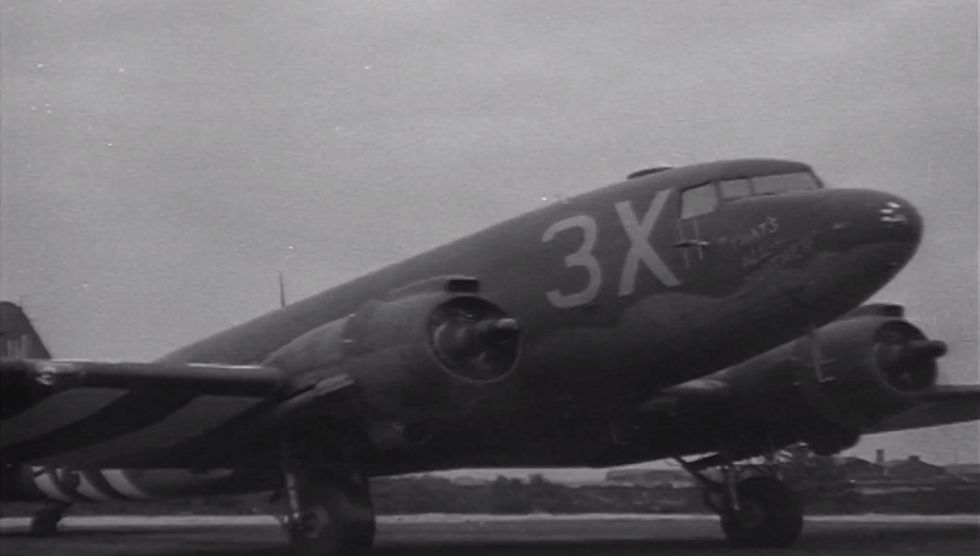A quick apology for the format, we had done some "as it happened" posting using a couple of the public timelines and pick up the story toward the end.
D-Day June 6, 1944 01:21 Double BST
The timelines were from
https://www.telegraph.co.uk/history/world-war-two/10878674/D-Day-6th-June-1944-as-it-happened-live.htmland:
https://www.dday-overlord.com/en/d-day/timelineWe'll stop here with the story of the first American troop transport to cross the French coastline (remember, the British loonies in the gliders landed an hour earlier)*
From the Smithsonian Air & Space Museum, August 2015:
Crowdsourcing Saves D-Day’s First Airplane

And from Warbird News, January 31, 2018:
‘That’s All, Brother’ Takes to the Skies!!!
*****.....The plan is to get the plane to Normandy in time for the 75th anniversary next year.
*****
Well, the volunteers did it, raised the money, made it airworthy, got it back to Europe. Not just any plane that was there on June 6, 1944 but the plane that led the way for the Americans.
From Popular Mechanics, June 4:
On June 6, 1944, a lone C-47 led the Normandy invasion. Seventy-five years later, the plane will do it again.
On the night before the D-Day landings on June 6th, 1944, an aerial armada set out from England for Normandy. These were transports, Douglas C-47 Skytrains (or Dakotas) and C-53 Skytroopers, carrying elite paratroopers on a mission to seize objectives ahead of the seaborne landings. The lead plane of this main force was a C-47A bearing the name "That’s All, Brother.”Seventy-five years later, the same C-47A will fly over Normandy, a unique memorial to those who took part in one of the most important moments of WWII.The Spearhead of the Spearhead
Commemorative Air Force
....MUCH MOREThat’s All, Brother was the lead plane for Mission Albany, the operation to capture causeways leading from Utah Beach as well as bridges, a canal lock, and a German coastal battery. 432 aircraft flew the mission, carrying almost seven thousand troops.Lt. Col. John M. Donalson, Commander of the 438th Troop Carrier Group, chose the aircraft’s name as a message to Hitler–once the airborne assault started it was a sign the game was up and “That’s all, brother.” The phrase was also popular due to a 1939 jazz standard called Comes Love, with the lyric:That's all brother, if you've ever been in love
That's all, brother, you know what I'm speaking ofThe C-47A is a military version of the celebrated DC-3 airliner. The usual flight crew for a C-47A was four—a pilot, co-pilot, navigator and radio operator. As the command aircraft, That’s All, Brother had a crew of seven, including Donalson.Also on board was Donalson’s Scottie dog (dogs were very popular with WWII airmen.) The paratroopers they carried were men of the 502nd Parachute Infantry Regiment, part of the 101st Airborne Division, and sitting in the dark as the plane lumbered toward France would have been a nerve-wracking experience.***“The noise level is rather loud,” says James Dagg, who led the restoration effort for the Commemorative Air Force. The plane is not pressurized, and the 1,200-horsepower air-cooled 14-cylinder radial piston engines were not built with modern noise standards in mind. The waiting paratroopers would also have been enveloped in a smell unlike any modern airliner....
*Our usual boilerplate on the British glider troops and their pilots:
From the lunatic glider troops of the British 6th Airborne Division securing the Pegasus Bridge at 0016 hrs in Operation Deadstick, the pilots landing within yards of their objective, in freakin' gliders!, with a skill that Sir Trafford Leigh-Mallory, the commander of Allied air forces, would later praise as the finest feat of flying in the entire war.
